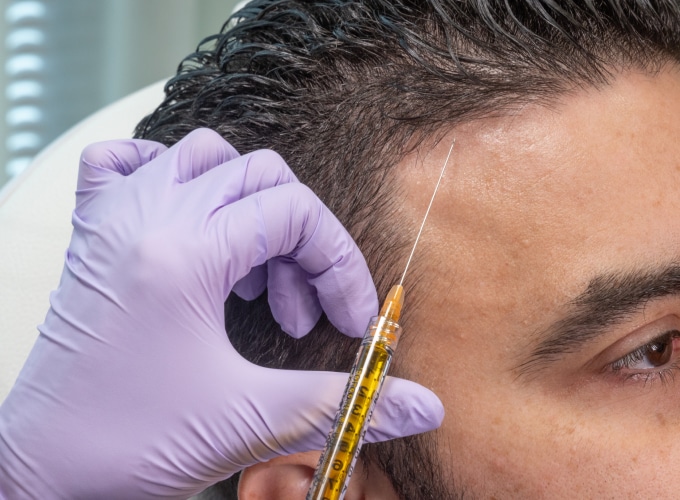Hair loss can strike at any age, and it often leads to a significant drop in self-esteem. Among the latest innovations for combating hair thinning and early baldness, GFC (Growth Factor Concentrate) hair treatment stands out for its regenerative capabilities. This non-surgical therapy harnesses the body’s growth factors to stimulate natural hair regrowth. Many individuals considering this treatment often ask: What is the best age to undergo GFC hair therapy? Understanding this is essential to achieving optimal results. While age is a critical factor, it intertwines closely with the progression of hair loss and scalp health. If you’re exploring this procedure, it’s equally important to assess the Cost of GFC Hair Treatment in Dubai, especially since affordability and timing can influence your decision to begin therapy.
Understanding GFC Hair Treatment: A Doctor’s Approach
GFC hair treatment is a modern, non-invasive therapy performed by trained dermatologists and trichologists. The procedure revolves around extracting a patient’s blood, processing it to isolate the platelet-derived growth factors, and re-injecting it into areas of the scalp experiencing thinning or early-stage baldness.
What sets this apart from traditional treatments is its personalized, science-driven mechanism. It’s not a generalized drug-based solution; rather, it’s a physician-monitored biological procedure. Doctors utilize state-of-the-art centrifugation and separation techniques to ensure maximum concentration of growth factors. This precision requires deep anatomical knowledge of scalp structure and hair follicle behavior, which is why only certified professionals administer the treatment.

Ideal Age for GFC Hair Treatment: What Experts Say
The best age for GFC hair treatment is closely linked to the biological cycle of hair and the stage of hair loss, rather than a strict numerical value. However, medical experts generally agree that individuals between the ages of 25 and 45 respond most effectively to GFC therapy. Here’s why:
- Early Detection, Better Response: Patients in their late 20s to early 30s usually catch hair loss in its early stages. Since GFC works best when there are active but weakened follicles present, this age group has a higher chance of revitalizing natural hair.
- Hormonal Stability: By your mid-20s, hormonal patterns stabilize. Doctors often note better treatment outcomes when underlying hormonal fluctuations (common in teens and early 20s) are minimal.
- Proactive Recovery: Patients between 25 and 40 tend to be more proactive about their health and are more likely to follow through on treatment protocols and post-care.
That said, age alone isn’t the only factor. Some younger individuals—particularly those experiencing early genetic hair thinning—can also be good candidates if their scalp condition supports growth factor absorption.
Why Early Treatment is Crucial
According to trichologists, the success of GFC treatment hinges on follicular activity. Hair follicles that are dormant for too long may become fibrotic and unresponsive. When patients wait too long, the chances of full recovery decrease.
Doctors advocate for treatment when:
- The scalp shows visible thinning but still has viable follicles.
- Hair density starts to reduce at the crown or temples.
- Hair becomes increasingly brittle or sheds excessively.
Younger candidates—those in their late 20s and 30s—tend to have more resilient follicles, allowing the injected growth factors to trigger faster and more robust regrowth.
How Doctors Evaluate Suitability Beyond Age
A skilled specialist never bases GFC eligibility on age alone. Instead, a multifaceted assessment is conducted. During the diagnostic phase, the doctor will examine:
- Scalp condition: Inflammation, dandruff, or infection can reduce treatment efficacy. These are addressed before therapy.
- Hair loss classification: Using the Norwood or Ludwig scale, doctors identify the progression level.
- Medical history: Conditions like thyroid imbalance or chronic illnesses are screened out or managed prior.
- Lifestyle analysis: Stress, diet, and haircare habits are discussed to tailor results further.
This comprehensive evaluation allows the doctor to gauge how well a person, regardless of age, may respond to GFC treatment.
Doctor’s Protocol During the Treatment Sessions
GFC therapy is entirely managed by trained professionals using standardized protocols to ensure consistent results. Each session follows a clinical pathway that includes:
- Blood Collection: Approximately 16–20 ml of the patient’s blood is drawn.
- Centrifugation: Advanced machines isolate platelets and extract growth factors through a proprietary process.
- Injection Process: Doctors carefully inject the concentrate across the thinning areas of the scalp using fine needles. Precision here is key—the injection points are strategically planned for maximum follicular stimulation.
The process is repeated monthly for three to four sessions. Dermatologists often adjust the concentration and volume of GFC depending on observed hair regrowth, providing a truly customized approach.
Post-Treatment Monitoring and Doctor-Led Follow-Up
Medical oversight doesn’t end after the last injection. Doctors follow up regularly to monitor scalp progress and regrowth timelines. Most specialists recommend bi-annual or annual reviews post-treatment to sustain results. They may conduct comparative imaging and trichoscopic evaluations to analyze hair shaft thickness and density.
In some cases, minor top-up sessions are advised every 9 to 12 months to maintain outcomes—again, fully supervised and adjusted by the practitioner based on visual and digital data.
Age-Specific Insights from Medical Professionals
Let’s look at how doctors approach GFC treatment for different age brackets:
- Under 25: GFC may be considered for patients with early-stage androgenetic alopecia. However, hormonal assessments and detailed scalp evaluation are crucial before proceeding.
- 25–35: This age group typically experiences early hair thinning. Doctors often recommend starting GFC now for best results, as follicles are still responsive and regrowth can be quick and uniform.
- 35–45: Treatment is still highly effective, especially if thinning areas still have hair density. Medical professionals focus more on boosting scalp nutrition and regular maintenance at this stage.
- 45+: Doctors evaluate follicle activity before suggesting GFC. In cases of significant baldness or fibrosis, other regenerative options might be recommended in combination.
Each age group requires a tailored protocol, and this is where a seasoned doctor’s experience becomes irreplaceable.
Benefits of GFC Hair Treatment – From a Clinical Lens
GFC hair therapy isn’t just another trend—it’s a scientifically backed, doctor-led solution for hair thinning. Patients who undergo this treatment under expert supervision experience several benefits:
- Natural Hair Regrowth: Unlike synthetic solutions, GFC boosts the body’s own regenerative response, resulting in naturally thick hair.
- No Downtime: Conducted in clinical settings, the procedure is quick and doesn’t disrupt daily life.
- Minimally Invasive: Doctors use fine micro-needles, making the process nearly painless with no incisions or surgeries.
- Precision-Driven: With each step performed by certified professionals, the therapy ensures safety and effectiveness.
- Custom Protocols: Each patient receives a strategy customized to their unique scalp physiology, age, and progression of hair loss.
- Boosted Confidence: With visible hair density improvements within weeks, patients often report a significant uplift in self-image and confidence.
These benefits are maximized only when the treatment is supervised and executed by a skilled specialist—proving that professional expertise is just as vital as the procedure itself.
Why Doctor Expertise Matters More Than Age
While the age factor plays a central role, the success of GFC treatment heavily relies on the medical team’s proficiency. Doctors with a background in trichology, dermatology, or regenerative medicine offer the best insights and techniques. They:
- Identify subtle signs of scalp health that most patients miss.
- Ensure sterile, safe, and regulated environments for all sessions.
- Monitor the progression accurately using advanced diagnostic tools.
- Know when to introduce complementary therapies if needed.
This level of professional oversight can dramatically influence how well the hair responds to GFC—sometimes even overriding the age factor entirely.
Conclusion
GFC hair treatment stands as one of the most advanced and minimally invasive solutions for early-stage hair loss. The ideal age to begin this therapy is typically between 25 and 45 years, a period during which hair follicles are most responsive to growth stimulation. However, suitability also depends on individual scalp conditions and hair loss progression, as assessed by expert dermatologists.
When administered by certified specialists using precision-based protocols, GFC therapy can yield exceptional results across various age groups. Whether you’re in your late 20s and noticing early thinning or in your 40s seeking to restore density, a doctor-guided approach ensures the safest and most effective path forward.































